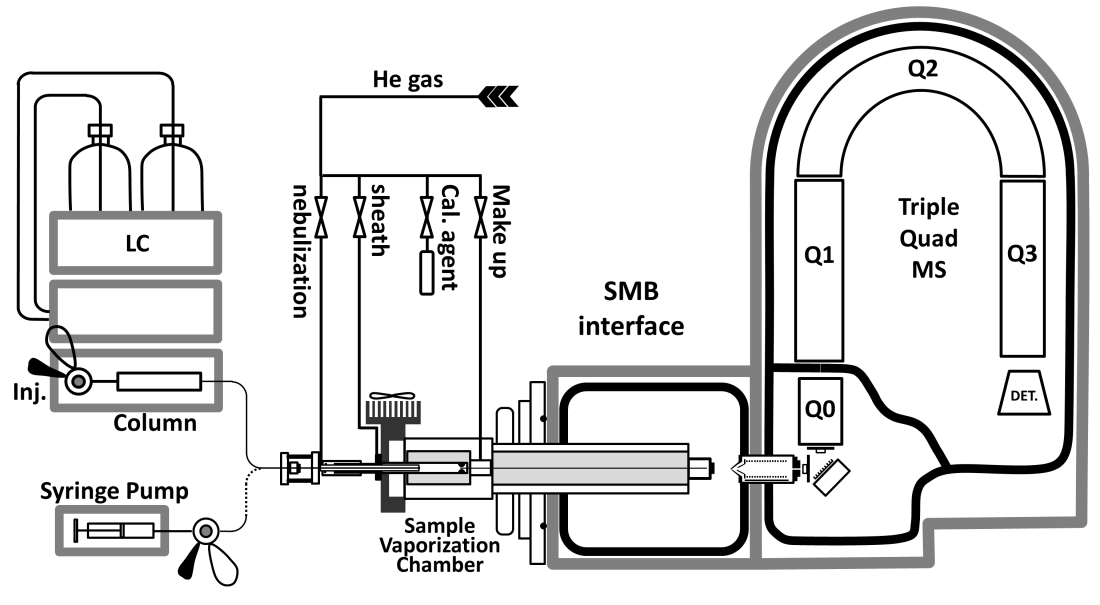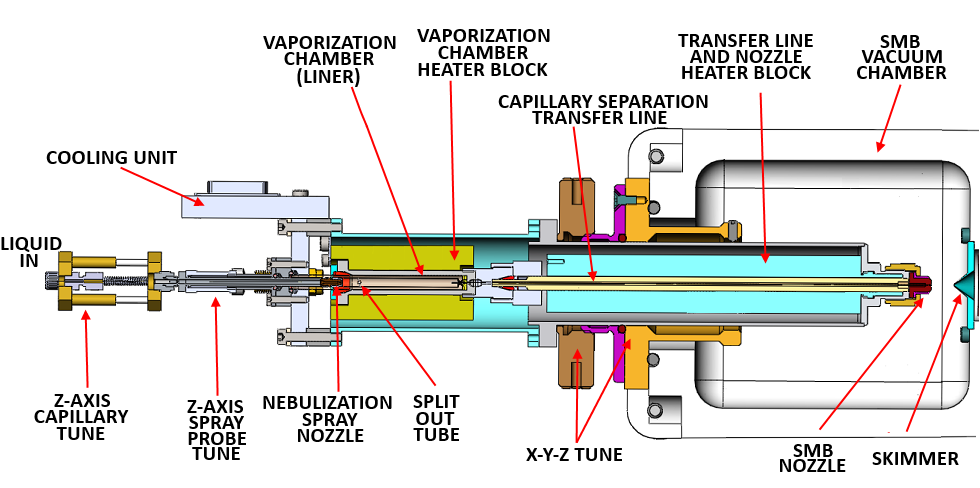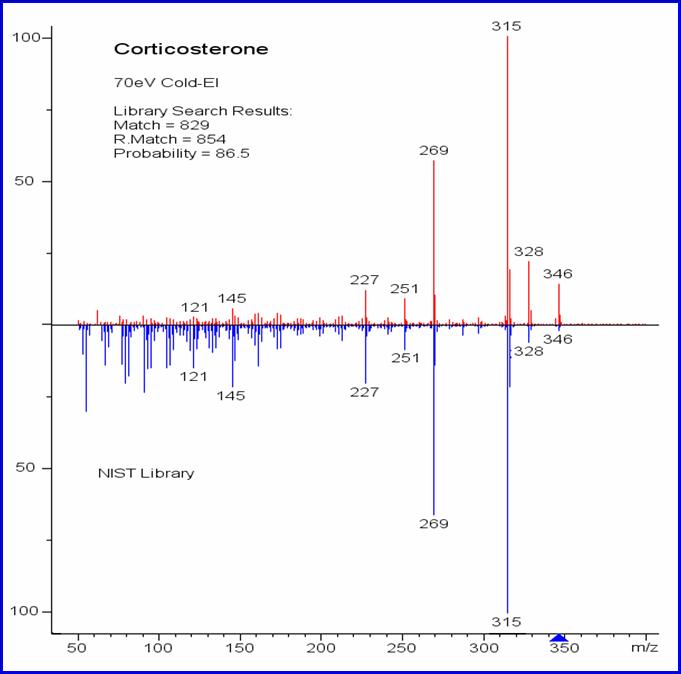Electron Ionization LC-MS with Supersonic Molecular Beams
Electron Ionization LC-MS for Automated Library Based Sample Identification, Elimination of Matrix Induced Ion Suppression Effects and having GC-MS and LC-MS in a one MS system with Easy Method Based Switching
Aviv Amirav, Ori Granot, Alexander B. Fialkov, Tal Alon, Boaz Seemann and Svetlana Tsizin. (June 2022)
The Novel Concept
Electron ionization (EI) can significantly benefit LC-MS through the provision of automated library identification and extensive fragment information which is ideally suitable for LC-MS identification of unknown compounds. Thus, bringing back EI to LC-MS is highly valuable if a reliable and robust EI interface can be developed. Motivated by the above challenge we developed a new approach for LC-MS (Israel, USA and Japan patents), aimed at obtaining high quality library searchable electron ionization (EI) mass spectra for a broad range of samples in liquids.
Our novel EI-LC-MS approach is based on interfacing LC and MS with supersonic molecular beams (SMB) and electron ionization of the sample as vibrationally cold compounds in the SMB (Cold EI).This system and its operational methods are based on pneumatic spray formation of the LC liquid flow in a heated spray vaporization chamber, full sample thermal vaporization and subsequent electron ionization of vibrationally cold molecules in the SMB. The vaporized sample compounds are transferred into a supersonic nozzle via a flow restrictor capillary. Consequently, while the pneumatic spray is formed and vaporized at above atmospheric pressure the supersonic nozzle backing pressure is about 0.15 Bar for the formation of supersonic molecular beams with vibrationally cold sample molecules without cluster formation with the solvent vapor. The sample compounds are ionized in a fly-though EI ion source as vibrationally cold molecules in the SMB, resulting in "Cold EI" (EI of vibrationally cold molecules) mass spectra that exhibit the standard EI fragments combined with enhanced molecular ions. We evaluated the EI-LC-MS with SMB system and demonstrated its effectiveness in NIST library sample identification which is complemented with the availability of enhanced molecular ions. The EI-LC-MS with SMB system is characterized by linear response of five orders of magnitude and uniform compound independent response including for non-polar compounds. This feature improves sample quantitation that can be approximated without compound specific calibration. Cold EI, like EI, is free from ion suppression and/or enhancement effects (that plague ESI and/or APCI) which facilitate faster LC separation since full separation is not essential. The absence of ion suppression effects enables the exploration of fast flow injection MS-MS as an alternative to lengthy LC-MS analysis. Our approach was experimentally tested and several thermally labile compounds that are not amenable for gas chromatography analysis were successfully analyzed, including underivatized steroids such as stanozolol and corticosterone, drugs such as reserpine sulfamerazine and erythromycin, a vitamin such as beta-carotene, explosives such as TATP, pesticides such as aldicarb and methomyl and polystyrene oligomers up to 1800 amu. High quality, library searchable, EI mass spectra were obtained for all these compounds and no peak tailing was observed with flow injection analysis. We demonstrate below the analysis of the main ingredients of Cannabis on a few Cannabis flower extracts and list the advantages of EI-LC-MS with SMB.
An active research with long-term commitment is underway on EI-LC-MS with SMB, performed on a dedicated home made "EI-LC-MS with SMB" apparatus which is based on a Varian 1200 triple quadrupole MS that was converted into LC-MS with Cold EI. We shall soon evaluate our new EI-LC-MS with SMB system that is based on Agilent 5977 MSD.
Advantages and Unique Features of Our EI-LC-MS with SMB
Our novel approach of liquid sampling mass spectrometry with supersonic molecular beams possesses several unique advantages over the current state of the art:
 1. Library
searchable EI mass spectra are provided (unlike with ESI or APCI/APPI) for positive, legally defensible sample
identification at the isomer level.
1. Library
searchable EI mass spectra are provided (unlike with ESI or APCI/APPI) for positive, legally defensible sample
identification at the isomer level.
 2. No matrix induced ion suppression or enhancements effects. The collision free
conditions of EI of sample compounds in SMB ensure full elimination of any ion
molecule reactions with their adverse suppression and/or enhancement effects.
2. No matrix induced ion suppression or enhancements effects. The collision free
conditions of EI of sample compounds in SMB ensure full elimination of any ion
molecule reactions with their adverse suppression and/or enhancement effects.
 3. The same MS system can serve for both GC-MS and EI-LC-MS with SMB with
automated method based conversion from mode to mode of operation.
3. The same MS system can serve for both GC-MS and EI-LC-MS with SMB with
automated method based conversion from mode to mode of operation.
 4. Enhanced
molecular ion is provided together with the library searchable
fragments for improved confidence level in the identification. Higher
quality
mass spectra are provided in comparison with Particle Beam-MS or any
other
liquid sampling MS methods. Cold EI (EI of vibrationally cold molecules
in SMB) provides the ultimate structural and isomer mass spectral
information
and is the best tool for unknown sample identification.
4. Enhanced
molecular ion is provided together with the library searchable
fragments for improved confidence level in the identification. Higher
quality
mass spectra are provided in comparison with Particle Beam-MS or any
other
liquid sampling MS methods. Cold EI (EI of vibrationally cold molecules
in SMB) provides the ultimate structural and isomer mass spectral
information
and is the best tool for unknown sample identification.
 5. Fast LC-MS
analysis can be achieved via the lack of ion suppression and/or enhancement
effects hence the ability to tolerate partial co elutions. Fast LC-MS is further
facilitated by using AMDIS
(automated mass spectral deconvolution identification software of NIST
that
is provided free with each NIST library) for enabling high throughput
analysis
combined with sample identification under co-elution conditions.
5. Fast LC-MS
analysis can be achieved via the lack of ion suppression and/or enhancement
effects hence the ability to tolerate partial co elutions. Fast LC-MS is further
facilitated by using AMDIS
(automated mass spectral deconvolution identification software of NIST
that
is provided free with each NIST library) for enabling high throughput
analysis
combined with sample identification under co-elution conditions.
 6. Non-polar
compounds are amenable for LC-MS analysis in addition to
the standard range of APCI compounds. Small, and even volatile
compounds
can be analyzed together with relatively large and thermally labile
compounds.
6. Non-polar
compounds are amenable for LC-MS analysis in addition to
the standard range of APCI compounds. Small, and even volatile
compounds
can be analyzed together with relatively large and thermally labile
compounds.
 7. Relatively uniform response is observed for a broad
range of compounds,
including non-polar compounds, due to the uniform ionization efficiency
of EI, and transfer of the SMB interface. Thus, even without sample identification, one can obtain an estimate of the
concentration of unknown samples and thus determine if their
identification is needed.
7. Relatively uniform response is observed for a broad
range of compounds,
including non-polar compounds, due to the uniform ionization efficiency
of EI, and transfer of the SMB interface. Thus, even without sample identification, one can obtain an estimate of the
concentration of unknown samples and thus determine if their
identification is needed.
 8. Isotope
abundance analysis can be performed for the provision of elemental formulae and isotope labeling
information
with a unit mass resolution quadrupole mass analyzer.
8. Isotope
abundance analysis can be performed for the provision of elemental formulae and isotope labeling
information
with a unit mass resolution quadrupole mass analyzer.
 9. No nitrogen
gas generator is required (in contrast to APCI and
ESI) since the
vaporized solvent in combination with small helium nebulyzing gas flow rate serve as the supersonic molecular beam gas
that can be provided by a cylinder.
Thus,
the cost and laboratory space of the nitrogen gas generator is
saved and the system can even be transportable.
9. No nitrogen
gas generator is required (in contrast to APCI and
ESI) since the
vaporized solvent in combination with small helium nebulyzing gas flow rate serve as the supersonic molecular beam gas
that can be provided by a cylinder.
Thus,
the cost and laboratory space of the nitrogen gas generator is
saved and the system can even be transportable.
 10. Higher EI sensitivity is obtained in comparison with
Particle
Beam-MS. Current minimum detected amount
is
about 1 picogram in SIM mode for several compounds.
This
detection limit is far better than that of Particle Beam.
10. Higher EI sensitivity is obtained in comparison with
Particle
Beam-MS. Current minimum detected amount
is
about 1 picogram in SIM mode for several compounds.
This
detection limit is far better than that of Particle Beam.
 11. Low cost. Our
vision is of a dedicated EI-LC-MS system that will
use the MS system of a standard GC-MS with the addition of one
differential
pumping chamber and replacement of the EI ion source with our fly through cold EI
ion source. The use of limited
mass range mass analyzer, simpler ion optics, simpler vacuum system and
elimination of nitrogen gas generator could enable the industry lowest
cost LC-MS system. Furthermore,
the same MS system could serve for both GC-MS and LC-MS with supersonic
molecular beams.
11. Low cost. Our
vision is of a dedicated EI-LC-MS system that will
use the MS system of a standard GC-MS with the addition of one
differential
pumping chamber and replacement of the EI ion source with our fly through cold EI
ion source. The use of limited
mass range mass analyzer, simpler ion optics, simpler vacuum system and
elimination of nitrogen gas generator could enable the industry lowest
cost LC-MS system. Furthermore,
the same MS system could serve for both GC-MS and LC-MS with supersonic
molecular beams.
![]()
Selected Available Results
In Figures 1 and 2 below a schematic diagram of the EI-LC-MS system is shown with its capillary separated vaporization chamber and nozzle system.

Figure 1. Electron Ionization LC-MS with SMB system outline. The liquid is introduced either from an HPLC system after its column or from a syringe pump to the heated vaporization chamber through a pneumatic nebulizer. The helium nebulization gas enters the SMB interface through a nebulization gas line, sheath gas line and nozzle make up gas line (indicated). The SMB interface is separately pumped by a turbo molecular pump and the vibrationally cold sample molecules fly through the ion source while the produced ions followed 90° deflection into the Varian 1200L triple quadrupole MS.

Figure 2 – Detailed view of the EI-LC-MS interface, from the liquid inlet to the skimmer. The adjustable spray nebulizer is located between the cooling unit and the heater block for maximum axial temperature gradient. The center of the interface is the separately heated sample spray formation and vaporization. The separately heated transfer-line also accommodates the fused silica capillary that serves as a flow restrictor that governs the gas flow rate into the SMB nozzle and vacuum chamber. The supersonic molecular beam nozzle center is adjusted to the skimmer concentrically by the X-Y-Z tune.
In Figure 3 below, the Cold EI mass spectrum of corticosterone in methanol solution is shown in the upper trace, and it is compared with the standard NIST EI library mass spectrum shown in the lower trace. Note the similarity of the library mass spectrum to that obtained with the SMB apparatus. All the major high mass ions of m/z 227, 251, 269 and 315 are with practically identical relative intensities and thus good library search results are enabled with NIST library matching factor of 829, reversed matching factor of 854 and 86.5% confidence level (identification probability) in the corticosterone identification. In addition, the molecular ion at m/z = 346 is now clearly observed while it is practically missing in the library (very small in the shown mass spectrum and absent in the other three replica mass spectra). The relative abundance of the high-mass ion at m/z = 328 is also enhanced. On the other hand, low mass fragments are suppressed and the overall effect of vibrational cooling on the appearance of the Cold EI mass spectrum is of shifting intensity from low mass fragments to high mass fragments and in particular to the molecular ion. Overall, the obtained NIST matching factors are high but usually are not as high as obtained with standard EI. However, the identification probability factors and confidence level in the identification is actually higher with Cold EI as found in the analysis of many pesticides and other compounds. We claim that the availability of the molecular ion is of critical importance for correct sample identification with high confidence level, particularly with thermally labile compounds. For example, in the NIST hit list other candidates appear after corticosterone, such as corticosteroneacetate (m/z = 388), which is listed as number two with 10.8% probability, since its standard EI mass spectrum is almost identical to that of corticosterone. The reason for this is that the standard EI MS of both compounds exhibit no molecular ion while having exactly the same fragments (and structure) of m/z = 315 and even a small m/z = 328. This observation is typical in a series of homologous compounds and well known for large aliphatic hydrocarbons that all show mostly m/z = 43, 57, 71 and 85 fragments. Consequently, having both a clear molecular ion peak at m/z = 346 and lack of a any ion peak at m/z = 388 unambiguously indicates that the sample compound is corticosterone and not corticosteroneacetate. Similarly, several other candidates in the NIST hit list are eliminated resulting in almost 100% probability that the sample is corticosterone or one of its isomers (1.2% probability).

Figure 3. A comparison of Cold EI mass spectrum of Corticosterone obtained with the EI-LC-MS with SMB system and its NIST library standard EI mass spectrum
I

Figure 4. Flow injection analysis by EI-MS-MS of diazinon in 8 fruits and vegetable QuEChERS extract. As shown, the flow injection peak of spiked diazinon (100 ng/ml) is the sum of peak of blank QuEChERS extract plus diazinon in clean acetonitril solution. This figure serves as a clear evidence that in EI-LC-MS with SMB there are no matrix induced ion suppression or enhancement effects even if all the matrix coelutes with the sample. Consequently, the road for fast flow injection EI-MS-MS as a fast alternative to standard LC-MS is now open.

Figure 5. Typical EI-LC-MS with SMB system detection limits with Octafluorenaphthalene, pyrene and the indicated propeller shaped 774 amu compound. Our SIM LOD is around 1-2 pg and is relatively independent on the test compound due to the uniform EI ionization yield. Our record LODs were 0.2 pg for OFN and 0.3 pg for tetrahydrocannabinol (THC). In addition, we found that our cold EI linear dynamic range extends above five orders of magnitude.

Figure 6. Cannabis flower analysis with EI-LC-MS with SMB. The extract was injected through a 5 µL loop to a C18 Phenomenex Luna column with 5µm particles 150 mm X 1.0 mm by VARIAN ProStar-210 LC. The solvent gradient was set to 60 µL/min flow rate of 50% water for 1 minute and reaching 100% methanol after 5 minute. The vaporization chamber and the transfer line were set to 300°C.
![]()
Further details of our approach and results are described in:
2. Boaz Seeman, Tal Alon, Svetlana Tsizin, Alexander Fialkov and Aviv Amirav "Electron Ionization LC-MS with Supersonic Molecular Beams – The New Concept Benefits and Applications" J. Mass. Spectrom. 50, 1252-1263 (2015).
3.
Svetlana Tsizin,
Ramesh Bokka, Uri Keshet, Tal Alon, Alexander B. Fialkov, Noam Tal and Aviv
Amirav "Comparison of Electrospray LC-MS , LC-MS with Cold EI and GC-MS with
Cold EI for Sample Identification" Int. J. Mass Spectrom. 422,
119-125 (2017).
4. Svetlana Tsizin, Alexander B. Fialkov and Aviv Amirav, "Electron Ionization Mass Spectrometry for Both Liquid and Gas Chromatography in One System without the Need for Hardware Adjustments" J. Am. Soc. Mass Spectrom. 31, 1713-1721 (2020).
5. Svetlana Tsizin, Alexander B. Fialkov, and Aviv Amirav, "Analysis of
Impurities in Pharmaceuticals by LC-MS with Cold Electron Ionization" J.
Mass. Spectrom.
55,
e4587 (2020).
For further EI-LC-MS with SMB information and about its possible commercial availability please contact me through my E-mail: amirav@tau.ac.il